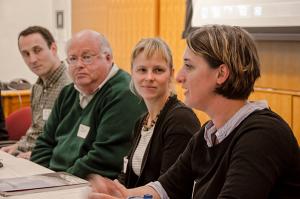For years, research into West Coast oyster hatchery die-offs has pointed the finger at Vibrio tubiashii. Now Oregon State University researchers believe a different, but related, bacterium – V. coralliilyticus – may be the real culprit.
The findings were published in Applied and Environmental Microbiology, by researchers from OSU’s College of Veterinary Medicine, the U.S. Department of Agriculture, and Rutgers University. The research was supported by the USDA.
“These bacteria are very similar, they’re close cousins,” said Claudia Häse, an OSU associate professor and expert in microbial pathogenesis. “V. coralliilyticus was believed to primarily infect warm water corals and contributes to coral bleaching around the world. It shares some gene sequences with V. tubiashii, but when we finally were able to compare the entire genomes, it became apparent that most of what we’re dealing with in the Pacific Northwest is V. coralliilyticus.”
Scientists now say that V. coralliilyticus is not only far more widespread than previously believed, but that it can infect a variety of fish, shellfish and oysters, including rainbow trout and larval brine shrimp. And it appears to be the primary offender in bacterial attacks on Pacific Northwest oyster larvae.
Häse’s previous work with Chris Langdon of OSU’s Molluscan Broodstock Lab has been supported in part by Oregon Sea Grant, which has also worked with Northwest shellfish growers to help them rebound from oyster die-offs. By learning to counter the effects of increasingly acidic seawater, which prevents larval oysters from forming the shells they need to survive, many hatcheries have seen production return.
But while hatchery stocks are recovering, the scientists say bacterial infections remain a real problem for oysters – and other organisms – in the wild.
“Although we’ve largely addressed the problems the hatcheries face, these bacteria continue to pose threats to wild oysters,” Häse said. “And corals are still declining in many places, the Great Barrier Reef in Australia is dying at an alarming rate. Better diagnostics might help in all of these situations.”
Learn more
- Read the full news release from OSU News & Research Communication
- Confluence, summer 2013: How Oregon Sea Grant research and extension helped Oregon hatcheries recover from near collapse (.pdf)







 Symposium on Thursday, November 13, 2014 from 1:30 pm to 5 pm in the Joyce Powell Leadership Center Journey Room in the OSU Memorial Union!
Symposium on Thursday, November 13, 2014 from 1:30 pm to 5 pm in the Joyce Powell Leadership Center Journey Room in the OSU Memorial Union!